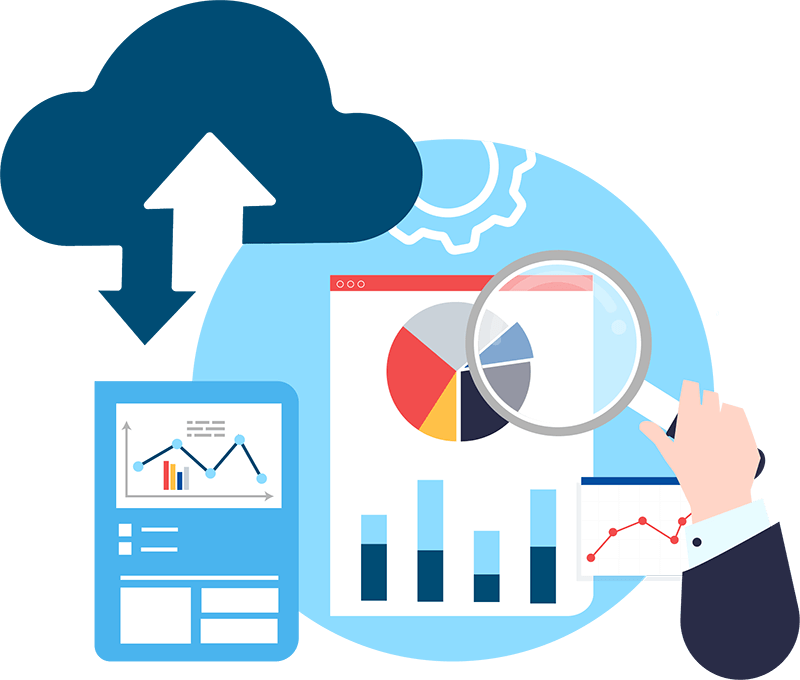
In today’s fast-paced digital landscape, innovation and IT transformation have become essential for businesses striving to achieve long-term success. A well-structured digital transformation strategy enables organizations to enhance customer experiences, bolster reliability and security, and maintain a competitive edge. By breaking down the digital transformation process into key stages, businesses can better understand the fundamental principles and unlock their full potential in the digital age.
Step 1: Conduct a comprehensive analysis of business processes and IT infrastructure
Developing a successful digital transformation plan begins with thoroughly assessing your present IT infrastructure and business procedures. This evaluation helps uncover inefficiencies, identify bottlenecks, and establish a clear transformation roadmap. By thoroughly evaluating the existing systems, organizations can lay a strong foundation for successful digitalization. Key parameters to analyze at this stage include:
1. Current architecture and operational efficiency
2. Server utilization and productivity
3. Condition of active and passive network equipment
4. Software applications in use
5. Short-term and long-term risks
6. Existing security measures
7. Business continuity plans
This comprehensive assessment ensures a clear understanding of your business’s starting point and creates a strategic direction for future improvements.
Step 2: Explore the technology landscape to enhance your digital transformation strategy
The next step in crafting a robust digital transformation strategy is investigating the available technology landscape. The IT department must identify opportunities to eliminate inefficiencies and replace outdated systems with modern, scalable solutions. Experts evaluate various options to address detected challenges, selecting the best technologies that align with the organization’s unique needs.
Key technologies to consider for digital transformation include:
Containers
Because of their capacity to streamline cloud operations, containers are a leading example of innovation in the IT industry. They allow multiple applications to run on a single machine with fast provisioning and complete resource isolation. Unlike traditional virtual machines, containers such as those powered by Docker are more agile, consume fewer resources, and offer almost complete independence from the underlying infrastructure.
This shift from virtual machines to container-based solutions has enabled large enterprises to build flexible cloud IT infrastructures and efficiently support R&D workloads. By incorporating container technology into their digital transformation strategies, businesses can streamline operations and enhance scalability in today’s competitive environment.
Cloud solutions: SaaS, PaaS, and IaaS for digital transformation
Traditional on-premise IT infrastructure quickly becomes outdated, often within 3-5 years, as businesses face ever-growing IT resource demands. Companies increasingly turn to cloud services to stay competitive, which have become a cornerstone of digital transformation strategies. The three primary cloud service models—SaaS, PaaS, and IaaS—offer unique benefits to streamline operations and reduce costs.
IaaS provides businesses with a flexible way to build their infrastructure using virtual servers and machines. This model allows companies to access the same IT resources as traditional hardware without heavy capital investments. By adopting IaaS, businesses can eliminate the burdens of maintaining and upgrading outdated in-house equipment.
PaaS takes cloud solutions a step further by offering a fully managed platform for application deployment. Unlike IaaS, which focuses on virtual machines, PaaS provides an all-in-one environment for developing, testing, and managing applications in the cloud. This solution simplifies the software development process and accelerates time-to-market for applications.
SaaS is the most user-friendly cloud model, providing ready-to-use applications that end-users can access immediately after sign-up. This accessibility makes SaaS especially valuable for rapidly growing small and medium-sized businesses. SaaS solutions streamline digital transformation, enabling companies to scale operations quickly while reducing project timelines from months to days.
Why cloud migration matters
A specialized and automated solution for migrating workloads from on-premises data centers to the cloud—or across multi-cloud environments—can significantly enhance a company’s cloud transformation strategy. These tools, backed by 100% RESTful API coverage, ensure seamless automation and integration with existing management systems.
Incorporating SaaS, PaaS, and IaaS into your digital transformation roadmap optimizes IT resources and positions your business for sustainable growth in today’s fast-paced digital landscape.
Workload management: Budget & provisioning control in cloud environments
While cloud IT environments offer numerous advantages, businesses often face challenges like overspending on cloud resources and inadequate budget and quota control. Hybrid cloud management platforms are key to overcoming these obstacles. They provide complete transparency into budget allocation and provisioning control, making them essential in any digital transformation strategy.
These platforms offer budget-driven IT resource management, allowing businesses to forecast cloud costs and track budgets and quotas assigned to different business units, projects, or users. With predictive insights, detailed reporting, and resource optimization powered by advanced data analytics, hybrid cloud management platforms help prevent budget overruns. Businesses may optimize cloud spending and guarantee effective resource allocation by analyzing past data and present IT usage.
IT Resilience and disaster recovery
As businesses increasingly rely on online platforms, cloud computing and networks have become even more critical. This rapid growth has also led to an uptick in cyber-attacks, making cybersecurity an essential element of any digital transformation. A comprehensive digital transformation strategy now includes a thorough analysis of security risks, potential vulnerabilities, and proactive measures to prevent cyber threats.
In addition to cybersecurity, Disaster Recovery (DR) and Business Continuity (BC) planning have become integral to maintaining operations. Many mistakenly believe that DR strategies are only needed by high-tech companies where downtime costs can reach millions of dollars. However, companies of all sizes can suffer significant financial losses and reputational damage from unexpected downtime.
A Disaster Recovery and Business Continuity plan is crucial for the fintech, telecommunications, tech, and manufacturing sectors. Advanced, fully automated DR software enables companies to replicate workloads from both virtual and physical environments to any cloud platform, ensuring minimal Recovery Point Objectives (RPO) and Recovery Time Objectives (RTO).
These solutions allow businesses to boot devices directly from cloud-native snapshots, minimizing downtime and offering sophisticated failback mechanisms to return workloads without data loss. With automated DR, companies can restore operations within a planned maintenance window, protecting their data and reputation.
Embracing cloud-based workload management and disaster recovery solutions is critical for ensuring your company’s resilience, security, and operational continuity in today’s digital-first landscape.

Step 3: Evaluating the costs and benefits of implementation
As part of a digital transformation strategy, companies must assess the economic value of adopting new technologies and phasing out outdated software. Before making a final decision, businesses must carefully evaluate the upfront implementation costs and the long-term benefits.
Recent studies indicate that investing in a hybrid cloud management platform can reduce monthly cloud expenses by as much as 35%. Cloud and virtualization technologies shift costs from capital expenditures (CAPEX) to operating expenses (OPEX), allowing businesses to reallocate capital to other priorities. This strategic shift makes it easier to control costs while enabling growth and innovation.
Step 4: Evaluating the impact of new technologies
Predictive insights play a key role in understanding the potential benefits of implementing new technologies. Businesses can assess the effectiveness of new solutions using the following approaches:
1. Complex, high-cost technologies: Businesses must conduct a comprehensive cost-benefit analysis of these solutions to determine whether the long-term advantages justify the initial investment.
2. Simple, ready-to-use technologies: For easier-to-deploy solutions, companies can implement a pilot version and assess results through team feedback and performance metrics.
Step 5: Assessing and refining digital transformation results
Digital transformation strategy requires ongoing analysis of trends, feedback from other business units, and alignment with industry standards. Regularly reviewing results and adjusting approaches based on new insights and developments will help businesses stay on track and optimize the transformation process.
If you are still hesitant about initiating a digital transformation, looking at successful case studies from other businesses can provide practical insights and inspire confidence in decision-making. These examples highlight how adopting the right technology can drive efficiency and enhance overall business performance.

Digital transformation success stories: How leading companies leveraged cloud solutions
Adobe's cloud innovation with Microsoft Azure
Adobe should enhance its customer insights and engagement with content created through Adobe Creative Cloud. To achieve this, Adobe developed the Adobe Experience Cloud, which integrates advanced data analytics with content creation, audience targeting, and campaign management. By partnering with Microsoft, Adobe integrated the Experience Cloud with Microsoft Azure and Dynamics 365, offering businesses a 360-degree view of their customers. This powerful collaboration enables companies to create, deliver, and manage personalized digital experiences, all supported by the scalability and security of Microsoft Azure’s global cloud platform.
Expedia's global expansion with Amazon Web Services (AWS)
Expedia has been on a continuous digital transformation journey to enhance the user and customer experience. With challenges in delivering fast and responsive services from its on-premise data centers in Chandler, AZ, Expedia turned to Amazon Web Services (AWS) to scale its operations globally. Since 2010, Expedia has migrated many critical applications to the cloud and plans to move 80% of its mission-critical workloads to AWS shortly. This migration helps Expedia reduce latency, improve operational efficiency, and enhance its ability to scale in response to global demand.
Target's agility boost with Google Cloud Platform
Target’s decision to move to Google Cloud was driven by the need to overcome the operational inefficiencies and high costs caused by downtime during peak periods like Cyber Monday. By migrating to Google Cloud, Target gained the ability to scale infrastructure quickly, reducing provisioning time from weeks to minutes. This shift has resulted in a more agile and responsive IT environment, significantly improving online performance. The move to Google Cloud has enhanced Target’s customer experience and driven greater customer satisfaction and loyalty through improved website reliability during high-demand events.
As a conclusion
These success stories show how top companies leverage cloud technologies—such as Microsoft Azure, AWS, and Google Cloud Platform—to fuel their digital transformation, improve operational efficiency, and deliver enhanced customer experiences. By embracing cloud-based solutions, businesses stay competitive, scalable, and agile in this evolving digital landscape.
Today, cloud computing is witnessing significant trends, such as integrating AI and machine learning, adopting hybrid and multi-cloud strategies, and focusing on sustainable cloud practices. These developments enhance operational efficiency, scalability, and environmental responsibility in the tech industry.

